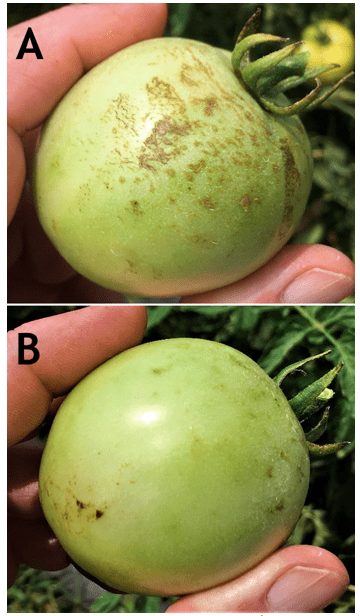Jerry Brust, IPM Vegetable Specialist, University of Maryland; jbrust@umd.edu
Over the last few weeks in almost all of the tomato fields I’ve been in have rain check on the tomato fruit (Fig. 1). Rain check is the many, tiny concentric cracks that form on the shoulder of the fruit and these small cracks can expand over time into unsightly scabs. The cracks feel rough to the touch and affected fruit do not develop proper color as it ripens. Damage will be most visible on exposed, mature green fruit after rains; but at times even small, immature green fruit can be affected. Rain check is mostly observed on large, fresh-market tomatoes, rather than on smaller cultivars. The exact cause is not known but appears to be related to exposure of the fruit to rain. An example of this can be seen on tomato fruit that is not covered by foliage and is exposed to rain often will have rain check but the underside of the same fruit will not (Fig. 2). The problem is more severe when heavy rains occur after a long dry period with high humidity. The rain might alter the fruit temperature or water uptake, which may impede the development of the shoulder epidermis.
Cultivars can vary in their susceptibility to rain check. Those tomato cultivars that have good leaf coverage that protect the fruit and good epidermal characteristics seem to be more tolerant of rain check. Glossy fruit tends to have less of a problem with rain check than dull fruit. I have mentioned this before about using a 30% shade cloth to reduce quality problems with tomato fruit, and in my studies not a single fruit under any of the shade canopies developed rain check while the other uncovered tomatoes (same cultivars) had 15-20% rain check.


